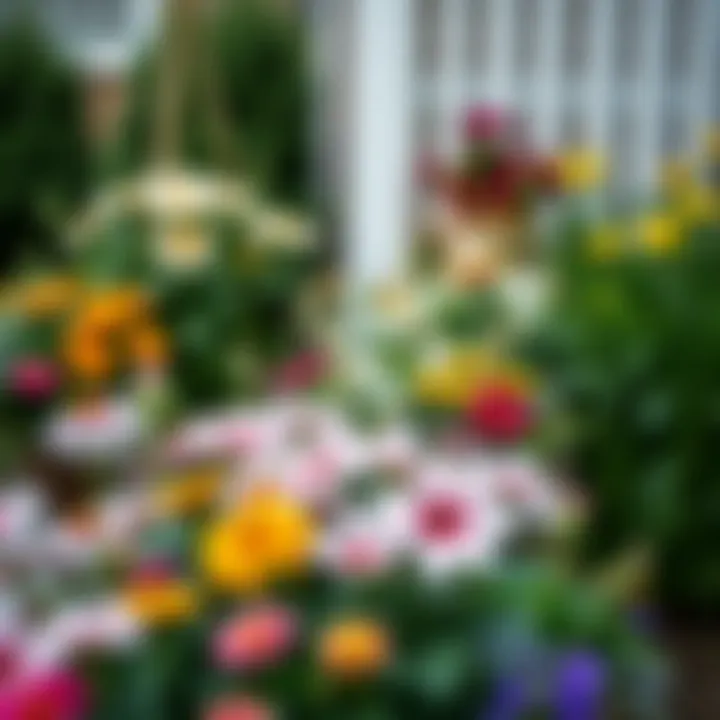Landscaping Ideas for Zone 5: Create Resilient Spaces


Intro
Creating an inviting outdoor space that thrives in the unique climate of Zone 5 involves a blend of creativity and practicality. As many homeowners face the challenge of selecting the right plants and designing layouts that will not only look good but also stand the test of time, it's crucial to understand the specific needs of this hardiness zone.
Zone 5 is characterized by its cold winters and warm summers, resulting in a growing season that is often shorter than in more temperate zones. However, with knowledgeable planning and thoughtful design, residents can cultivate vibrant, resilient landscapes that will flourish year after year. This article aims to provide you with a multifaceted guide that highlights effective landscaping ideas tailored specifically for Zone 5, covering everything from plant selection to design inspirations and maintenance tips.
In this guide, we'll dig into:
- The best plants to choose for durability and visual interest,
- Innovative design strategies that harmonize with the surroundings,
- Essential seasonal maintenance practices to keep landscapes flourishing,
- Insights into creating color palettes that enliven your outdoor spaces.
Understanding the nuances of your environment is paramount, and this guide is designed not just to impart knowledge but also to inspire creativity. Whether you're looking to spruce up your garden or create an entertaining area for gatherings, the ideas within this article can help you develop a space that's both stunning and sustainable.
Understanding Zone Climate
Understanding the climate of Zone 5 is crucial for anyone looking to create thriving outdoor spaces. The benefits of grasping its unique characteristics are manifold, guiding both plant selection and design strategies. This section serves as a foundation for creating resilient landscapes adapted to Zone 5's conditions.
Defining Zone
Zone 5 is classified by the USDA Plant Hardiness Zone Map and encompasses regions where winter temperatures can drop to as low as -20°F (-29°C) to -10°F (-23°C). This classification helps gardeners and homeowners identify which plants can best survive the specific climate of their area. Knowing this zone can save you time and money, steering you away from planting varieties that simply won't thrive here. Essentially, Zone 5 acts as a reliable GPS for green spaces, ensuring that every choice contributes to a healthy ecosystem.
Climate Considerations
Climate is the bedrock upon which effective landscaping is built. When discussing Zone 5, there are three main components of climate to take into account: temperature range, frost dates, and precipitation patterns.
Temperature Range
The temperature range in Zone 5 is characterized by moderate cold, where winter chills can extend significantly. This unique climate means that species adapted to cooler conditions are the best candidates for gardens here. Plants like daylilies, peonies, and even certain fruit trees like apples, have a better chance of flourishing, owing to their cold hardiness. Additionally, the predictable temperature patterns lend themselves well to careful planning, allowing for seasonal rotations.
Frost Dates
Frost dates dictate the growing season, guiding when to plant and harvest. In Zone 5, the last frost typically falls between late April and early May, while the first frost may arrive around mid to late October. Understanding these dates helps prevent gardeners from losing precious young plants to an unexpected freeze, ultimately leading to a more productive growing cycle. For those looking to maximize yields, timing becomes paramount. Notably, employing season extenders, like row covers or cold frames, can provide an additional buffer against those unexpected chilly evenings.
Precipitation Patterns
Zone 5 generally experiences a good mix of rainfall and seasonal snow, with annual precipitation often ranging from 30 to 40 inches. This moisture is vital for plant health and influences irrigation strategies for gardens. Understanding local precipitation patterns can inform a homeowner whether to go for drought-resistant plants or lush, thirsty varieties. This aspect not only contributes to a thriving landscape but efficiently uses available water resources, showcasing a sustainable and responsible approach to gardening.
Soil Types in Zone
In addition to climate, soil type and characteristics play a pivotal role in successful landscaping efforts.
Common Soil Characteristics
Soils in Zone 5 can be diverse, but many areas feature fertile loam or clay soils. With loam, you'll find a good balance of sand, silt, and clay, making it versatile for many plant types. Meanwhile, clay can retain moisture well but may also create drainage issues. Knowing what your soil comprises is essential since these characteristics affect everything from root development to nutrient availability. For example, heavy clay soils might require amending to improve drainage, thus facilitating better air flow for roots.
Soil Testing and Amendments
Testing soil before planting is a wise move, as it reveals pH levels and nutrient content. Homeowners can easily conduct tests using kits available through garden centers or local agricultural extensions. Depending on the results, you may need to introduce amendments like lime to raise pH or sulfur to lower it, optimizing conditions for the plants you choose to incorporate. Adjusting soil composition not only boosts the health of your garden but also fosters sustainability—good practices lead to better ecosystems.
"Understanding your local climate and soil type is key to creating a resilient landscape tailored to your spaces."
In summary, grasping the intricacies of Zone 5's climate and soil lays the groundwork for successful landscaping. By being aware of temperature ranges, frost dates, and soil characteristics, you position yourself to make informed choices that support a flourishing garden.
Key Factors for Successful Landscaping
When diving into landscape design, especially for Zone 5, understanding key factors is non-negotiable. This zone can be as challenging as it is rewarding. It's not just about planting a few pretty flowers; it's about creating a resilient ecosystem that’ll thrive through fluctuating weather, soil conditions, and seasonal changes.
With that in mind, taking the time to analyze your site, considering sustainable practices, and making informed decisions can yield stunning and lasting results.
Site Analysis
Topography and Drainage
Topography plays a crucial role in determining how water will flow through your landscape. In layman's terms, it’s about the shape of the land. Slopes can direct rainwater away, which can be an issue for some plants. Conversely, flat areas may retain water, leading to soggy conditions that some flora simply can’t handle. What works best? A balanced approach is ideal, utilizing slopes for water management while ensuring sufficient drainage.
Unique features like raised beds can be a good compromise. They help with water retention for certain plants while also ensuring they don’t sit in waterlogged conditions, which is a frequent pitfall in many gardens. Remember, good drainage is essential in creating a thriving landscape especially in diverse weather patterns.
Sunlight Exposure
Sunlight exposure is another critical piece of the puzzle. The amount of sun different areas get can shift throughout the day, influencing which plants will flourish where. Some sections may bask in full sun, while others could be shaded by structures, fences, or trees. Understanding these distinctions can transform a failed garden into a successful one.
Why is this important? Plants have specific sunlight needs, whether that's full sun, partial shade, or full shade. For example, lavender thrives in bright sunshine, while hostas prefer shadier locales. A keen understanding of these requirements ensures a harmonious garden that won’t leave you scratching your head come blooming season.
Microclimates
Microclimates are like little pockets of unique atmospheric conditions within your property. You might wonder why this matters in landscaping—well, microclimates can be a game changer. They’re influenced by factors such as elevation, water bodies, and structures that can reflect heat or provide shade.
These unique spaces can allow for a wider variety of plants. For instance, a south-facing wall can create warmth that facilitates growing tender plants that wouldn't normally survive in Zone 5. Understanding your microclimates can also help you with plant placement, making sure each plant thrives rather than merely survives.
Sustainable Practices
Water Conservation Techniques
In these times of appreciating our water resources, employing water conservation techniques can affect not just the health of your garden but also the local environment. Utilizing methods such as drip irrigation or rain barrels can keep your plants hydrated without wasting a drop. Why is this good? It reduces your water bill and acknowledges the need to protect our planet’s most precious resources.
A notable benefit is the flexibility it offers. Modern systems can be automated, so you don’t have to remember to water daily, taking pressure off busy schedules.
Native Plant Utilization


Using native plants is a wise way to approach landscaping in Zone 5. These plants are adapted to local climate conditions and often require less watering and maintenance. They also provide ecological benefits, such as attracting local wildlife, which is an added bonus for the ecosystem.
Choosing native flora, such as black-eyed Susans or coneflowers, can reduce the environmental impact of your garden and create a thriving habitat. It’s like giving nature a helping hand while keeping your garden vibrant.
Wildlife-Friendly Landscaping
Creating a space that welcomes backyard wildlife is like opening your garden’s door to nature’s wonders. This means incorporating elements like birdhouses, bee hotels, or even specific plants that attract butterflies. Why bother? By doing so, you're helping maintain local biodiversity.
However, there’s a balance to strike. Make sure that the plants and structures you choose are appropriate for the wildlife in your area, ensuring that distinctions between friend and foe stay clear. This responsibility pays off, enriching both your garden and the local environment.
Taking these factors into account not only enhances the appearance of your garden but also creates a resilient landscape that can withstand the challenges of Zone 5's unique climate.
Plant Selection for Zone
Selecting the right plants for landscaping in Zone 5 is more than just a choice; it's a vital step in ensuring the longevity and vitality of your outdoor space. The cruel reality is that not every plant will thrive in the specific conditions that this hardiness zone presents. By choosing appropriately, you pave the way for stunning gardens that offer abundant color and resilience. With the right selection, you foster a connection to the environment, embedding your landscape in the local ecosystem while reducing overall maintenance and resource use.
Perennial Plants
Popular Perennials
When it comes to popular perennials, some stand out like gems in a treasure chest. Plants such as Black-eyed Susans, Daylilies, and Peonies are cherished for their ease of growth and vibrant blooms. These perennials breathe life into any garden design. They not only return year after year but also play a significant role in providing structure and color across the seasons. The standout characteristic of these plants is their dormancy during winter, which ultimately helps them burst into life each spring.
Advantages: They have a low maintenance requirement and can improve soil health over time as they die back. However, be cautious about their spacing—if planted too closely, they might overwhelm one another or compete for nutrients.
Color Palettes and Bloom Times
Another asset to perennials is their unique ability to add color palettes that evolve with the months. For instance, pairing early-blooming Creeping Phlox with late-season Asters creates a seamless transition in visual interest. Understanding bloom times enables homeowners to plan for continuous color throughout the growing season, reinforcing the garden's appeal at every glance.
An important consideration is the use of color wheels to guide combinations that create harmony or contrast in your yard. By linking colors in a thoughtful way, you can accentuate features or provide balance throughout the landscape. However, it's imperative to choose wisely; certain colors clash, which could detract from the overall aesthetic.
Shrubs and Trees
Deciduous vs. Evergreen
Shrubs and trees play a crucial role in shaping the framework of your landscape. The choice between deciduous and evergreen trees can significantly impact the look of your garden throughout the year. Deciduous trees, such as Maples, shed their leaves in fall which can create an array of stunning autumn hues, making way for airy structures in winter. Meanwhile, evergreens, like Spruce or Holly, provide year-round visual interest and privacy—essential during snowy winters or for shielding against neighbors.
Each offers its benefits; deciduous trees allow sunlight to penetrate during winter, warming your space, while evergreens stand steadfast and resilient against harsh winds.
Height and Spread Considerations
Understanding the height and spread of plants is crucial for wise landscaping. Overcrowded shrubs can lead to small, sickly plants that struggle to survive. When choosing, consider mature dimensions, which helps maintain a balanced look and prevents competition for light and nutrients.
All these aspects should be factored in during the design phase. Certain species spread wide while others shoot straight upward, and mixing these appropriately is essential, both for aesthetics and health. Just picture a layout: the tall Bald Cypress could shade the shorter Lavender, creating a cozy nook in your garden.
Annuals and Seasonal Color
Choosing Annual Varieties
Annuals can be the icing on the cake in any landscape design, providing pops of color that perennial spaces may lack throughout the seasons. Selecting the right annuals allows for creativity—think vibrant Petunias, Zinnias, or Marigolds that liven up the garden from early spring through fall. Their main charm lies in their ability to fill gaps, turning bare spots into a splash of color.
However, their short-term nature means regular seasonal investment; you’ll need to replant annually, which can require considerations on expenses and time. This makes it vital to learn how to keep your selections diverse and fresh.
Utilizing Annuals for Seasonal Displays
Beyond just filling gaps, annuals can be strong focal points. Think of the effect of planting certain varieties in patterns or alternating colors, creating stunning displays that grace your space like a painter does on canvas. Leveraging annuals allows you to express a seasonal theme—colors of summer can fade into rich autumn tones.
Engaging in seasonal displays enhances both the ambience and aesthetic appeal of your landscape.
Choosing the right plants involves an understanding between aesthetics and the suitability of the flora for the local conditions in Zone 5.
Landscaping in Zone 5 provides ample opportunities, so harnessing the right plant selection unlocks potential that aligns with seasonal cycles, ecological health, and personal style. It’s not just about how the landscape looks today, but how it will evolve and flourish into the future.
Landscape Design Principles
Landscape design principles play a pivotal role in shaping outdoor spaces, influencing not only the aesthetic appeal but also the functionality of gardens in Zone 5. These principles guide homeowners through the intricacies of designing spaces that are not just visually pleasing but also practical in response to the unique climate of this hardiness zone.
Understanding focal points, the importance of balance and unity, as well as appropriate hardscaping options, can elevate your landscape. Each principle works in concert, ensuring gardens are neither chaotic nor sterile. This crafted approach cultivates environments that are engaging and harmonious, vital for vegetation health and human enjoyment.
Creating Focal Points
Water Features
Water features, such as ponds, fountains, or streams, serve as vibrant focal points in a garden. They add a visual and auditory element that draws one’s eye and creates a soothing ambiance. The most compelling characteristic of water features is their ability to attract wildlife, enhancing the ecological diversity of your garden. This makes them a standout choice for those looking to create a lively outdoor space.
Another unique quality of water features is their dynamic nature; they change with the weather and seasons. However, they do require maintenance, and improper installation can lead to drainage issues. Therefore, careful planning and consideration are needed before adding these elements to your landscape.
"Water features can turn any simple backyard into a retreat, offering a sensory experience that is unmatched by static designs."
Garden Statues and Art
Garden statues and art pieces are an excellent way to incorporate personal style into your outdoor space. They stand out as unique elements that can reflect hobbies, interests, or history. One notable characteristic is their permanence; these features provide a sense of stability and year-round interest in the landscape.
Incorporating art into the garden can also facilitate conversation and create points of intrigue for visitors. Just like water features, garden art can require a bit of maintenance to ensure it remains in good condition against harsh weather. Be mindful of selecting materials that can withstand the fluctuating climate of Zone 5.
Balance, Unity, and Harmony
Achieving balance, unity, and harmony in landscape design fosters a cohesive look across the garden. Balance involves the distribution of visual weight in a space, ensuring that no single element overwhelms another. Unity ties various elements together, using color schemes or themes that resonate throughout the space. Harmony allows those elements to work in concert, creating a space that is tranquil and pleasant to the senses.


All three principles are essential, especially for Zone 5, where diverse plant life thrives. A well-planned garden, displaying these principles, can resist pests and diseases while thriving in both beauty and stability.
Incorporating Hardscaping
Patios and Pathways
Patios and pathways are vital components of landscape design, functioning as connective tissue within the garden layout. While they offer practical routes through your space, they also enhance the overall design aesthetic. One key characteristic is their role in defining spaces, creating areas for relaxation or gatherings, which can significantly influence the usability of the garden.
Opting for materials that complement your plants and surrounding environment can tie hardscapes into the broader design. However, bear in mind that installing these features requires careful planning, particularly in relation to drainage. Poorly planned pathways can lead to standing water, which may adversely affect plant health.
Stone Walls and Edging
Stone walls and edging provide structure and delineation within landscaped areas. They can offer a rustic charm to your garden, often being chosen for their durability and aesthetic appeal. One of the critical aspects of stone walls is their ability to hold soil in place, especially on slopes. This capability can prevent erosion, crucial in Zone 5 where weather patterns can vary widely.
However, these materials can be costly and labor-intensive to install, so it’s essential to weigh these factors against the benefits they bring. Properly executed, stone walls can be functional as well as striking, adding a defined character to your outdoor environment.
Seasonal Maintenance Strategies
Maintaining an attractive and resilient landscape in Zone 5 goes beyond selecting the right plants and laying out an appealing design. Seasonal maintenance is critical. It allows gardeners to adapt to the changing weather, protect their plants, and ensure that their outdoor space thrives. Note that consistent care not only enhances beauty but also supports ecological balance and promotes healthy plant life.
A thoughtful approach to seasonal maintenance can make all the difference. Taking appropriate steps during spring, summer, fall, and winter can rejuvenate plants and prepare them for different challenges. Let's delve into the specific tasks that should be on every gardener's list.
Spring Preparations
Pruning and Mulching
Spring signifies a fresh start. As plants emerge from winter dormancy, pruning becomes vital. This involves removing dead or diseased branches from trees and shrubs. Pruning not only shapes the plant but encourages robust growth. The timing of pruning is also key; early spring is often ideal before new growth starts.
Mulching follows closely on the heels of pruning. In Zone 5, mulching helps retain soil moisture and regulate soil temperature as temperatures rise. It can suppress weeds, too. Many gardeners favor organic mulch, like bark or leaves, as it enriches the soil as it decomposes. One key characteristic of mulching is its ability to create a more stable environment for plants, which is especially beneficial during those unpredictable temperature swings common in early spring.
However, there is a catch: improper mulching can lead to excess moisture retention or pest problems if applied too thickly. Thus, moderation is key. With a balanced approach, combining pruning and mulching, gardeners set their landscapes up for the robust growth that is the hallmark of successful gardening.
Planting New Items
Springs is the perfect time to introduce new plants into your landscape. Selecting hardy perennials suited for Zone 5 not only adds variety but also ensures sustainability long term. When planting new items, consider factors such as location, sunlight exposure, and soil type.
One of the joys of planting in spring is the vast array of options available. From vibrant annuals to hardy perennials, spring planting infuses life into the garden that has been dormant through the winter. A key characteristic of planting during this season is the promise of immediate and future beauty. Not only does it add aesthetic value, it boosts local biodiversity.
However, one must take caution to not overwhelm the garden with too many new additions at once. Spacing is vital; overcrowding can stifles growth and lead to competition for nutrients. The unique feature of planting new items is it allows gardeners to try out varying combinations for visual interest while ensuring they respect the ecological balance of their space.
Summer Care
Irrigation Techniques
Summer can pose a real challenge for gardeners in Zone 5. With rising temperatures and potential drought, effective irrigation is crucial. Various techniques can be employed to keep the landscape hydrated without waste. Drip irrigation systems, for instance, deliver water directly to the root zone of plants, minimizing evaporation and runoff. Hand watering can also be effective, although it requires more time.
A notable advantage of proper irrigation techniques lies in their efficiency. By directing water where it's most needed, plants can thrive even in the heat. A solid irrigation plan results not only in healthier plants but also in conserving water.
On the downside, overwatering can lead to root rot and other issues. Therefore, it’s important to find that sweet spot, adjusting frequency and quantity based on rainfall and temperature.
Monitoring Plant Health
Keeping a close eye on plant health through the summer months cannot be overstated. Regularly checking for pests, disease, or nutrient deficiencies ensures plants receive timely intervention. Look for discoloration, wilting, or unusual growth patterns, as these can be signs of underlying issues.
One major benefit of monitoring plant health is that it fosters a proactive gardening approach. Rather than waiting for problems to escalate, early detection enables swift action. Communities often recommend keeping a gardening journal to track changes over time, a valuable tool for those managing expansive landscapes.
The unique aspect of this practice is the education it fosters. By understanding what makes healthy plants tick, homeowners can refine their gardening practices over time, resulting in a thriving, resilient landscape.
Fall Preparations
Preparing for Winter
As autumn settles in, the attention shifts towards readying the garden for winter. This means putting plants to bed and safeguarding them against cold temperatures. Clean up any fallen debris, which can harbor pests and diseases, and consider adding fall fertilizer to strengthen roots.
A key characteristic of proper winter preparation includes protecting less hardy plants with appropriate coverings or mulches. This ensures they have a fighting chance against the chill. By establishing a clean sanctuary in the autumn, the upcoming spring growth can be more vigorous.
One potential disadvantage lies in the time commitment it requires. However, the long-term benefits undoubtedly outweigh the short-term effort. Doing this work now pays off when you enjoy a vibrant landscape come spring.
Seasonal Planting Opportunities
Fall also presents unique planting opportunities. Certain bulbs, like tulips and daffodils, thrive when planted in the fall, blooming beautifully come spring. Additionally, fall is a suitable time to sow seeds for winter crops if you are willing to extend your growing season a bit.
A significant advantage of seasonal planting in fall is the limited competition from weeds and an abundance of available rainfall, making it easier for new plants to establish roots. Further, it provides a burst of color just when the garden needs it most.
Nevertheless, timing is everything. Beyond a certain point in late fall, the ground can become too cold, making planting unsuccessful. Thus, attentiveness is crucial; understanding seasonal windows of opportunity makes all the difference.
Winter Maintenance
Planning for Spring
Winter, although seemingly dormant, is an excellent time to strategize for the forthcoming gardening season. Start sketching out ideas for new layouts, plant combinations, and color schemes. It’s a productive way to keep the gardening spirit alive even in the colder months.
The key characteristic of planning during winter is that it allows for thoughtful consideration. Rather than rushed decisions made in the heat of spring, winter planning can lead to effective and sustainable designs when the thaw comes.
On the flip side, the disadvantage is that without practical engagement, motivation could dwindle. However, utilizing this time wisely can lead to fruitful collaboration, inspiration, and creativity when spring finally returns.
Protecting Perennials and Evergreens


Winter is a time to ensure that perennials and evergreens are adequately protected. Covering plants with burlap or frost cloth helps shield them from brutal winds and cold snaps, while mulching can insulate roots against freezing conditions.
A notable benefit of using protective measures is it significantly increases the chances of plant survival through harsh winters. These efforts also reduce the likelihood of frost damage and promote healthy regrowth come spring.
However, it’s important not to smother plants completely. Good airflow is necessary to prevent mold or rot, emphasizing the need for a balanced approach. Protecting these key elements in the garden keeps the landscape strong and ensures it can flourish in the sunny months ahead.
Landscaping Trends for Zone
Understanding the landscaping trends in Zone 5 is essential for crafting outdoor spaces that not only stand out but also thrive in this specific climate. The trends reflect a growing appreciation for sustainability, functionality, and aesthetic appeal. So, homeowners in Zone 5 should pay attention to these trends to maximize the potential of their gardens and yards. By adopting current practices, gardeners can support biodiversity, manage resources more efficiently, and cultivate spaces that look great year-round.
Modern Minimalism
Modern minimalism is resonating well with many landscapes in Zone 5, as it embraces simplicity and functionality. This trend focuses on clean lines, uncomplicated plantings, and a harmonious balance between natural elements and hardscaping. It's a response to the fast-paced, cluttered lives many lead today, encouraging a more peaceful environment outdoors.
One significant aspect of modern minimalism is the selection of geometric shapes in both the layout and plant choice. You might encounter a garden that features a small, neatly trimmed hedge surrounding a single focal tree or a strategically placed boulder among tidy pebbles. The minimalist approach invites tranquility, allowing the beauty of individual plants and materials to shine without overwhelming the senses.
In particular, monochromatic plant palettes, often consisting of shades of green with pops of color provided by seasonal blooms, create cohesion and peace. The benefit of this trend is that it reduces maintenance and allows for more time to enjoy the serene landscape. Moreover, the incorporation of hardscaped pathways made of stone or concrete complements this trend by enhancing function without compromising style.
Edible Landscaping
Edible landscaping is becoming more than just a trend; it’s evolving into a lifestyle choice for many Zone 5 homeowners. By blending aesthetics with practical food production, this approach allows for aesthetically pleasing gardens that also provide nourishment. It’s a way to reconnect with the earth and promote sustainability within one's immediate environment.
Designing Vegetable Gardens
When designing vegetable gardens, the focus should be on layout and accessibility. Raised beds are often a popular choice as they help in soil drainage and make planting easier on the back. The distinctive feature of vegetable gardens is their potential for seasonal beauty beyond just growing food. Imagine a sweet potato vine cascading over a rustic trellis or vibrant tomatoes mingling with marigolds to deter pests.
The advantage of incorporating vegetables is multifaceted – not only do they offer delicious produce, but they also integrate well with ornamental plants. Utilizing the design concept of companion planting can optimize space and promote plant health, allowing for a productive yet beautiful garden. However, one must be cautious; proper planning is key as improper placement can lead to shade issues or nutrient competition.
Incorporating Herbs and Fruits
The incorporation of herbs and fruits stands out as a key characteristic of many Zone 5 landscapes. Herbs such as rosemary, thyme, and mint not only enhance culinary creativity; they also add fragrance and texture to gardens. Fruits like strawberries, blueberries, and apples serve dual purposes, providing both beauty and sustenance.
The unique feature of using herbs is their low maintenance and versatility. They can thrive in varied conditions and can be planted in dedicated beds or intermixed with perennial flowers. This adaptability makes them a highly beneficial addition. The downside might be that certain fruits require specific care to thrive, but with the right approach, they can flourish beautifully in Zone 5's distinct climate.
"Sustainable landscaping isn’t just about plants; it's about creating environments that nourish the body and soul."
As trends continue to shape the landscaping scene, embracing modern minimalism and edible landscaping in Zone 5 showcases a blend of aesthetics and utility. Both approaches enhance the garden’s visual allure while aligning with contemporary values like sustainability and self-sufficiency, making them valuable considerations for the discerning homeowner.
Resources and Tools for the Gardener
Creating a lush and resilient landscape in Zone 5 requires more than just a green thumb. It takes the right resources and tools to execute those landscaping ideas effectively. From hand tools to online platforms, the resources available today not only make gardening easier but also enhance your ability to create a beautiful outdoor space. Understanding these resources can save you time, improve your efficiency, and help you achieve a successful garden that thrives in your local climate.
Gardening Tools
Essential Hand Tools
When tackling your garden, you’ll find that essential hand tools are your best friends. These tools typically include a trowel, pruners, and a spade, among others. Each tool serves a specific purpose, allowing for more precise work. For example, trowels help you dig small holes for planting while pruners are perfect for keeping your shrubs and trees in check.
One key characteristic of these hand tools is their lightweight design, which makes them easy to handle, especially for detailed tasks. This is why they are popular among gardeners; they allow for fine adjustments without the strain that heavier equipment might impose. Not every task requires brute force, and that’s where hand tools shine. They often feature durable materials like stainless steel for durability and comfort grips to enhance usability.
However, it's crucial to select high-quality tools, as cheaper options tend to wear out quickly or might even lead to injury if they malfunction. Therefore, invest in brands recognized for their craftsmanship to ensure longevity.
Power Tools for Efficiency
On the flip side, when the task list becomes lengthy, power tools for efficiency can come into play. Tools like electric hedge trimmers or powered tillers can significantly speed up tasks that often consume hours of manual labor. The primary advantage here is time savings; what might take you an afternoon with hand tools can often be done in mere minutes with the right power tool.
One standout feature of these power tools is their ability to tackle more extensive areas of your garden with ease, helping you partner effectively with the up-and-down nature of your landscaping projects. For instance, an electric tiller can break up tough soil quickly, making it easier to work before planting.
On the downside, these tools require maintenance and proper handling. They can also be costly, so it’s wise to determine when their use is justified based on the scale of your landscaping task.
Online Resources
Gardening Apps
In today’s digital age, gardening apps are a game changer. These applications allow you to track your garden activities, schedule watering, and even identify plant diseases by simply taking a picture. One notable characteristic of gardening apps is their ability to personalize the gardening experience. Many apps let you input your specific zone details and preferences, tailoring suggestions just for you.
Among the benefits, ease of accessibility stands out. You can have all the guidance you need right in your pocket while you’re working in the garden. A common disadvantage, however, might be the variety of choices available; navigating through different apps to find the best one can be daunting.
Virtual Gardening Communities
Finally, there's no underestimating the value of virtual gardening communities. These platforms, such as specialized forums and social media groups, bring together gardening enthusiasts from all walks of life. They offer valuable experiential knowledge and tips that might not be found in manuals or apps. Being able to ask questions and share your gardening victories fosters a sense of community that enhances the entire gardening journey.
The advantage here lies in the wealth of collective knowledge. You might find specific strategies for pest management or receive emotional support when plants fail to thrive. The downside? Misinformation can spread just as easily, so it’s best to cross-check shared advice against reputable sources.
"Whether you are using tried-and-true tools or tapping into the digital resources available today, having the right equipment can set you up for success in your garden."
End
In wrapping up the discussion regarding landscaping within Zone 5, it’s crucial to emphasize the significance of creating resilient outdoor spaces that not only enhance the aesthetic appeal of a property but also ensure sustainability. The concepts explored throughout this article underscore the unique challenges posed by the climate and soil conditions in this particular hardiness zone. With proper planning and informed plant selections, homeowners can cultivate landscapes that withstand the rigors of the changing seasons.
A well-designed landscape in Zone 5 speaks volumes about a homeowner’s commitment to not just beauty, but to environmental consciousness and thoughtful stewardship of local ecosystems. The integration of native plants, sustainable maintenance practices, and optimized plant placement based on microclimates can significantly reduce the effort needed for upkeep while enhancing biodiversity. Such landscapes become not just functional spaces, but thriving habitats as well.
Recap of Key Points
To summarize the insights shared:
- Understanding the climatic nuances and soil characteristics of Zone 5 informs plant selection and landscape design.
- Sustainable landscaping practices are essential for reducing water usage and fostering wildlife-friendly environments.
- Choosing the right plants—be it perennials, annuals, shrubs, or trees—tailored to the specific conditions can dramatically improve landscape resilience and beauty.
- Seasonal maintenance, from spring prep to winter preparations, is key to ensuring that the landscape remains vibrant and healthy throughout the year.
By taking advantage of these foundational principles and insights, homeowners can craft their outdoor spaces into resilient, beautiful environments that provide enjoyment for years to come.
Encouragement Toward Action
Now, it's time to put words into action. Start with a small project if needed—perhaps a vegetable patch or a flower bed featuring regional natives. Assess your space, develop a plan, and take those first steps, whether it's selecting the right plants or installing a simple irrigation system. Do not hesitate to reach out to local gardening communities or resources—websites like National Gardening Association or state agricultural extension services can provide invaluable support and information.
Let the design you create reflect your personality and values. Ultimately, embracing the principles discussed here will lead to an outdoor environment that resonates with resilience, beauty, and sustainability, all while being a source of pride and tranquility for you and your family in the years ahead.







